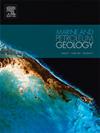Origin and accumulation of natural gas in the Sinian-Cambrian reservoirs of the central Sichuan Basin, southwest China: Implications from both closed and semi-open pyrolysis experiments
IF 3.7
2区 地球科学
Q1 GEOSCIENCES, MULTIDISCIPLINARY
引用次数: 0
Abstract
Large amounts of natural gas have been discovered in the Sinian-Cambrian reservoirs of the central Sichuan Basin, southwest China. However, the gas origin and accumulation patterns remain unresolved due to a poor understanding of the geochemical signatures for natural gas derived from cracking of paleo-oils. In this study, a Cambrian sourced oil sample and its SARA (saturates, aromatics, resins and asphaltenes) fractions were pyrolyzed in closed systems to investigate the effects of oil fraction composition on the molecular signature and methane carbon isotope composition of the generated gas. Meanwhile, the oil sample and its asphaltene fraction were further pyrolyzed in stepwise, semi-open system to investigate how possibly the geological openness affects the generation potential and geochemical signatures of the resulted gas from the cracking of oil and asphaltene. It is revealed that although the carbon isotopes of methane (δ13C1) generated from oils change with SARA compositions in the closed system, the δ13C1 values of natural gas from both asphaltene (representing kerogen) and three types of oils with different SARA compositions are lighter than −40‰, and differ significantly from the δ13C1 values of the present natural gas in the Sinian-Cambrian reservoirs. In semi-open systems, the generation potential of natural gases from residual asphaltenes and oils decrease drastically. The gases are dominated by methane with δ13C1 values range from −39.8‰ to −29.4‰, which could even be heavier than the δ13C values of original asphaltenes and oils. The geochemical signatures of the natural gases in the Sinian-Cambrian reservoirs are similar to those of gaseous pyrolyzates in the semi-open systems, suggesting that early-generated natural gases may have been partly lost and the late gas derived from residual oils and kerogen forms the present gas pools. The geochemical variation of natural gases in different Sinian-Cambrian reservoirs is primarily controlled by paleostructures. Higher positions of the paleo-uplift contain a higher proportion of early-generated gases and thus have higher gas wetness and lighter δ13C1 values, such as the natural gases in the Ziyang area and the Taihe area. In contrast, the natural gases in lower positions of the paleo-uplift have a higher proportion of late gases, characterized by lower gas wetness and heavier δ13C1 values, such as those in the Weiyuan gases field and the Anyue gas field.
求助全文
约1分钟内获得全文
求助全文
来源期刊

Marine and Petroleum Geology
地学-地球科学综合
CiteScore
8.80
自引率
14.30%
发文量
475
审稿时长
63 days
期刊介绍:
Marine and Petroleum Geology is the pre-eminent international forum for the exchange of multidisciplinary concepts, interpretations and techniques for all concerned with marine and petroleum geology in industry, government and academia. Rapid bimonthly publication allows early communications of papers or short communications to the geoscience community.
Marine and Petroleum Geology is essential reading for geologists, geophysicists and explorationists in industry, government and academia working in the following areas: marine geology; basin analysis and evaluation; organic geochemistry; reserve/resource estimation; seismic stratigraphy; thermal models of basic evolution; sedimentary geology; continental margins; geophysical interpretation; structural geology/tectonics; formation evaluation techniques; well logging.
 求助内容:
求助内容: 应助结果提醒方式:
应助结果提醒方式:


